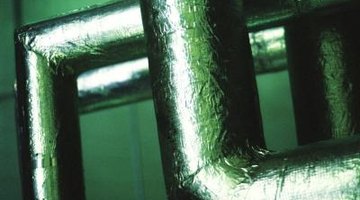How to Estimate Pipe Insulation
Insulating pipes is the best way to protect them against freezing in the winter. Well-insulated pipes can also save you money on energy costs, as well-insulated pipes take less time to heat up in the winter and cool off during the hot months. Estimating the costs of insulating your pipes will ultimately depend on several factors, including the size and of pipes you want to insulate and the type of insulation you want to use.

-
Measure the length of all of the pipes you plan to insulate and write down the total length. Also note the widths, or diameter, of the pipes you will be insulating. Typically, the standard diameter sizes for house pipes are 3/4 inch and 1 inch.
-
Count the total number of pipe elbows or joints you need to insulate. Write this number down.
-
Determine the type of pipe insulation you want to use. Foam insulation that wraps snugly around pipes is the most popular and cost-efficient type of pipe insulation on the market. It is typically sold in 6-foot lengths that cost approximately $2. 3/4-inch diameter insulation usually runs about 10 to 20 cents less than 1-inch diameter insulation. For estimating purposes though, round up to $2 per 6-foot length to cover both diameter sizes. Foam elbows, used to insulate U-curves in plumbing and pipes, cost approximately $1 to $1.50 each.
-
Multiply the total footage of pipe you intend to cover by $2.
-
Multiply the total number of insulated elbows you will need times $1.50 (or you can round up to $2 each just to be on the safe side).
-
Add these two totals up and it will give you an approximate value for the insulation costs for your specific job.
References
- Home Depot: Armacell 3/4 Inch by 6 Feet Tubolit Self-Seal Foam Pipe Insulation
- Insulate & Weatherize (Taunton's Build Like a Pro); Bruce Hartley; 2002
Writer Bio
Ashton Daigle, a New Orleans native, graduated from Southeastern Louisiana University in 1998 and went straight to work as a journalist. In 2005 he tackled the biggest news story of his life - Hurricane Katrina. Daigle is writing a collection of essays: What It Means to be a Saints Fan.
Photo Credits
- Liquidlibrary/liquidlibrary/Getty Images
More Articles
- How to Find the Center of a Pipe
- The Connection Between a Single Wall Pipe to a Triple Wall Pipe
- How to Calculate Developed Length in Plumbing
- How to Calculate the Wall Thickness of a Pipe
- Difference Between R-11 and R-15 Insulation
- How to Connect the Exhaust Fan to the 4" ABS Vent Pipe in Your House



